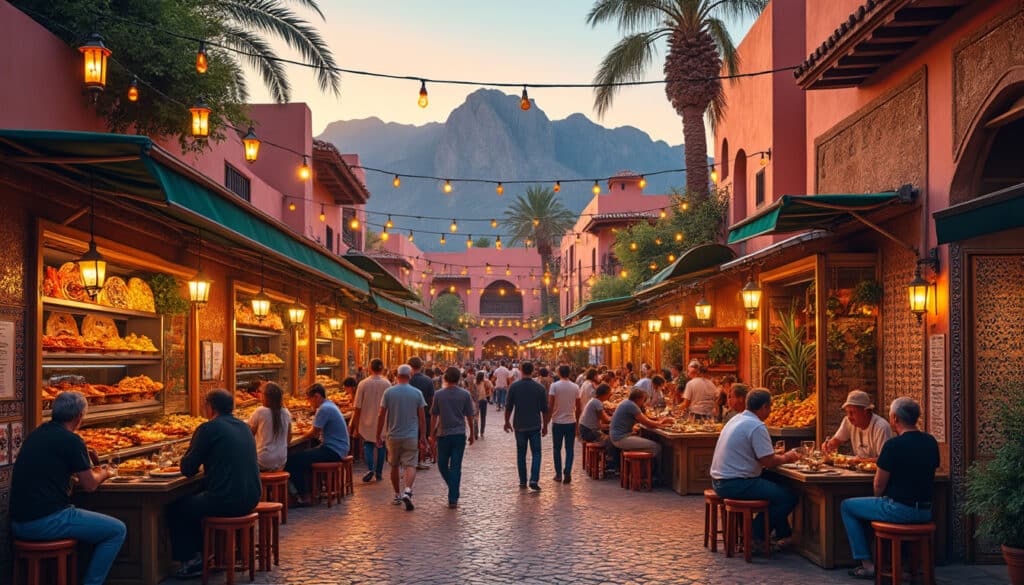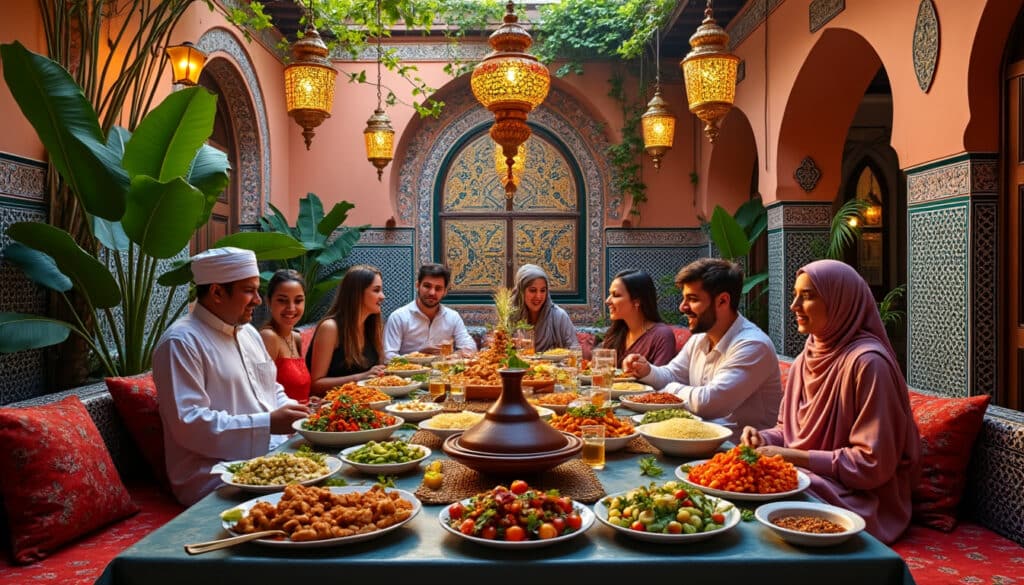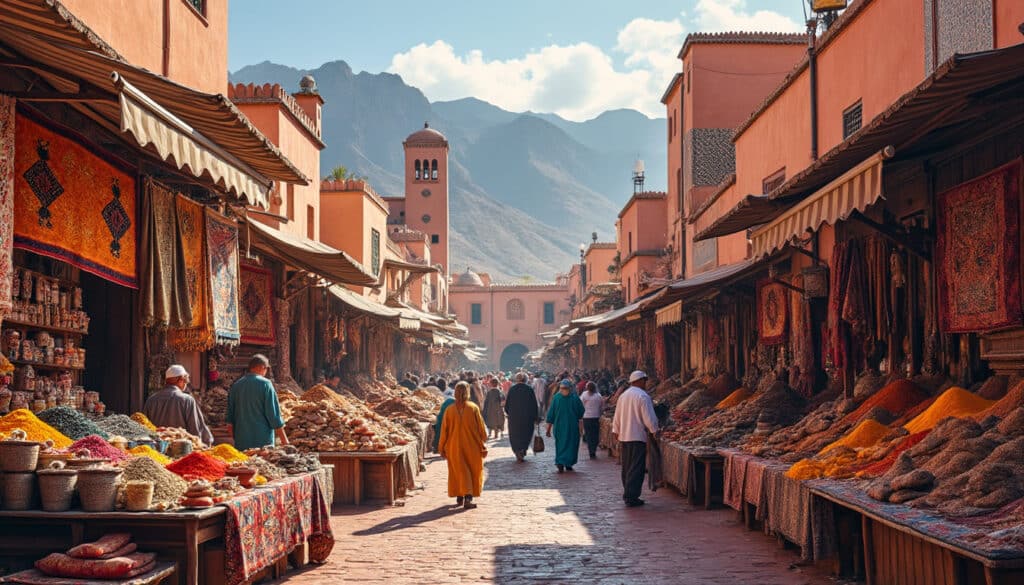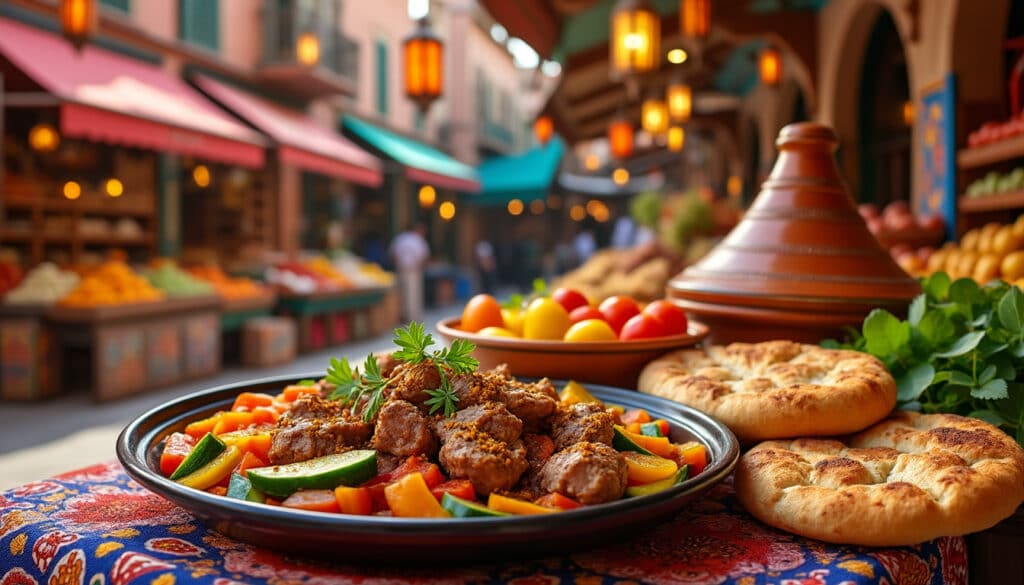Nestled at the crossroads of ancient caravan routes, Marrakesh is a vibrant kaleidoscope of history, culture, and languages. Known for its bustling medinas and exotic landscapes, the city of Marrakesh is a prime example of Morocco’s linguistic diversity, showcasing a unique blend of languages that reflects its multi-layered history. Understanding the languages of Marrakesh not only enriches a traveler’s experience but also provides invaluable cultural insights into the daily life and traditions of this fascinating city.
The Predominant Role of Moroccan Arabic in Marrakesh
Moroccan Arabic, locally known as Darija, is the predominant language spoken in Marrakesh. While it is a dialect of Arabic, Darija has developed its unique characteristics, which include loanwords from French, Berber, and even some Italian and Spanish. This potpourri of influences makes Darija a living testament to Morocco’s rich history of cultural exchange and migration.
For travelers heading to Marrakesh, understanding a few key phrases in Darija can greatly enhance communication with locals, especially in the vibrant markets and bustling souks. Although many Moroccans speak multiple languages, using Darija is a great way to connect with the people and show respect for their cultural identity. Here are some essential Darija phrases:
- 🗣️ Salam Alaikum – Hello
- 🗣️ Shukran – Thank you
- 🗣️ Laila saida – Good night
Despite its widespread use, Darija is rarely written, as most formal communications and official documents are in Modern Standard Arabic (MSA). This distinction highlights the diglossic nature of the Arabic language in Morocco, where the spoken and written forms differ significantly. However, Darija remains a crucial aspect of everyday interaction, showcasing the adaptability and resilience of language as a living cultural element.
For a deeper dive into how Darija intertwines with other languages like Berber, Arabic, and French, you might find educational platforms like the Mosaic Language Academy and Local Dialects Institute invaluable. These institutions offer courses and insights into the nuances of Moroccan linguistics, helping both locals and internationals alike to appreciate and understand the city’s lingual tapestry.

The Influence of French in Marrakesh
France’s colonial influence in Morocco, which began in the early 20th century and lasted until 1956, has indelibly marked Marrakesh’s linguistic landscape. French is widely spoken in the city and serves as a second language for a substantial portion of its population. In the realms of commerce, administration, education, and medicine, French holds a prestigious position, often being the medium through which transactions and dialogues occur.
This continued use of French underscores its role as a bridge language in Marrakesh, especially in areas frequented by tourists, where signage is often bilingual. Notably, French is the primary language of instruction in Moroccan schools for subjects such as science and mathematics, introduced again after the year 2000 following the end of a period of Arabization. This policy pivot acknowledged the limitations of promoting Arabic in all areas of education, especially where scientific and technical subjects are concerned.
Here’s a quick overview of how populations in Marrakesh and Morocco engage with French:
| 🎓 Language Ability | 🎯 Percentage of Population |
|---|---|
| Speak French | 57.7% |
| Read and Write in French | 66% |
The centrality of French in daily life makes it an essential tool for communication in social and professional settings, especially in tourist hubs like Marrakesh. Whether it’s reading road signs, conversing in a cafe, or conducting business meetings, French provides a versatile medium that enhances accessibility and understanding across a diverse urban populace. For anyone visiting or planning to live in Marrakesh, brushing up on French can be highly beneficial for smoother interactions.
Berber Languages: The Heartbeat of Tradition
Beyond Darija and French, Marrakesh is a mosaic of languages that tell the tale of its indigenous heritage. The Berber languages, also known as Amazigh languages, form a significant part of Morocco’s cultural identity, spoken by around 40% of the population. In Marrakesh and its surrounding regions, you will encounter different Berber dialects, predominantly Tarifit, Tamazight, and Taschelhit.
Tamazight gained recognition as an official language of Morocco in 2011, a monumental step towards preserving and promoting Berber cultural heritage. Following this constitutional amendment, educational reforms have been progressively introducing Tamazight into school curriculums, although full implementation is still a work in progress as of 2025. Here’s how the population distribution for Berber languages looks in the Marrakesh-Safi region:
| 🌍 Language | 🔢 % of Population | 🗺️ Region |
|---|---|---|
| Tamazight | 0.5% | Marrakesh-Safi |
| Taschelhit | 26.3% | Marrakesh-Safi |
The vibrancy of Berber languages in Marrakesh offers visitors a unique opportunity to explore Morocco’s cultural roots. Local institutions such as Tamazight Teachings and Berber & Arabic Learning offer courses that delve into the history, language, and traditions of the Berber people. These educational experiences provide a deeper appreciation of the cultural mosaic within which Marrakesh exists, bridging the gap between the past and the present.
The Rising Influence of English in Marrakesh
In recent years, English has gained significant traction in Marrakesh, reflecting its growing prominence on the global stage. As Morocco strengthens its ties with the international community, English is increasingly becoming an important language for business, tourism, and education. The decision by the Moroccan government to generalize the learning of English from secondary school level onward marks a strategic shift towards equipping future generations with this key global language.
According to the 2024 census, 20.5% of the Moroccan population was literate in English, and this figure is expected to rise as educational reforms continue to prioritize English language instruction. This change is evident in Marrakesh, where many younger residents are now proficient in English, and many signs, menus, and tourist information points also feature English.
English language schools and centers like the Marrakech Language Hub and Translingua Morocco provide opportunities for both Moroccans and expatriates to improve their language skills in structured environments. Here’s a quick comparison of language literacy in Marrakesh:
| 📘 Language | 🔡 Literacy Rate in Marrakesh |
|---|---|
| French | 66% |
| English | 20.5% |
| Berber | 1.5% |
This multilingual environment makes Marrakesh a fascinating case study in linguistic development, where the increasing use of English coexists with traditional languages, enriching the city’s cultural fabric. Whether engaging in business negotiations, enjoying cultural exchange, or exploring the rich tapestry of language on offer, visitors will find Marrakesh’s embracing of English a comforting bridge to the world beyond its walls.
Historical Mosaic of Languages in Marrakesh
The linguistic history of Marrakesh is as rich and varied as its vibrant souks and bustling streets. Tracing back to its foundation in the 11th century, Marrakesh has served as a melting pot where cultures and languages have interwoven to create a unique historical tapestry. Over the centuries, languages such as Phoenician, Punic, Greek, and Latin have all left their mark, giving way over time to various forms of Arabic and Berber with the changing rulerships and conquests.
During the Almohad period, the city witnessed an interesting fusion of Arabic and Berber influences, as sermons were delivered in both languages. This duality underscores Marrakesh’s role as a cultural junction, where different linguistic traditions coexisted and influenced one another. Understanding this historical backdrop provides essential cultural insights into how Marrakesh evolved into the multilingual city it is today.
Here’s a brief look at the historical language landscape in Marrakesh:
- 🏺 Phoenician – Early language influence via ancient trade
- 👑 Latin & Greek – From the rule of King Juba II
- 🏰 Arabic & Berber – Dominant throughout the Islamic conquests
The dynamic cultural exchange visible in Marrakesh extends beyond just spoken language. It’s a city where ancient traditions are celebrated with fervor, and modernity is embraced with enthusiasm. Visitors looking to delve deeper into this mosaic can explore educational platforms such as the Atlas Languages and the Language Connect, both of which provide comprehensive cultural programs and language workshops.
For those with a keen interest in linguistic history, Marrakesh offers a living case study in the evolution of language, where the echoes of its historical past continue to resonate within the vibrant, multilingual conversations of today.
FAQ about Languages in Marrakesh
| ❓ Question | ✅ Answer |
|---|---|
| Is French widely spoken throughout Marrakesh? | Yes, French is commonly used in education, business, and tourism sectors. |
| What are the main Berber languages spoken in Marrakesh? | Taschelhit and Tamazight are the main Berber dialects spoken. |
| Do people in Marrakesh speak English? | English is increasingly spoken, especially among younger generations and in tourist areas. |
| How does Darija differ from Modern Standard Arabic? | Darija is the local dialect with influences from Berber and French, while MSA is used for formal and written communication. |
| Can I find language schools in Marrakesh? | Yes, institutions like the Marrakech Language Hub offer language courses in Darija, French, and English. |

Culture & Local Life in Marrakesh
Marrakesh, a mosaic of vibrant colors, aromatic spices, and enduring traditions, offers an alluring escape for travelers seeking to immerse themselves in its unique culture. Known for its eclectic blend of ancient and modern, Marrakesh promises adventures at every turn,…

Best places to eat in Marrakesh
In the heart of Marrakesh, a city’s culinary landscape offers an exciting fusion of traditional flavors and contemporary innovations, making it a paradise for food enthusiasts. This vibrant city is renowned for its rich tapestry of tastes that span diverse…

Marrakesh, a vibrant tapestry woven with rich culture and history, is a culinary paradise that ignites the senses. From the bustling souks where aromatic spices beckon, to the serene courtyards of traditional riads, the city’s unique meal times offer travelers…

Souvenirs and shopping in Marrakesh
Marrakesh is an explosion of colors, scents, and sounds that captivate every visitor. As you navigate its intricate maze of souks and bustling markets, a treasure trove of Moroccan delights awaits. From aromatic spices to handcrafted jewelry, each purchase is…

What do people eat in Marrakesh?
Marrakesh, known as the Red City, offers an enchanting blend of historical charm and culinary delight. 🌆 As you journey through its bustling streets, you’ll be greeted by vibrant aromas wafting from numerous food stalls and restaurants. Moroccan cuisine, rich…


